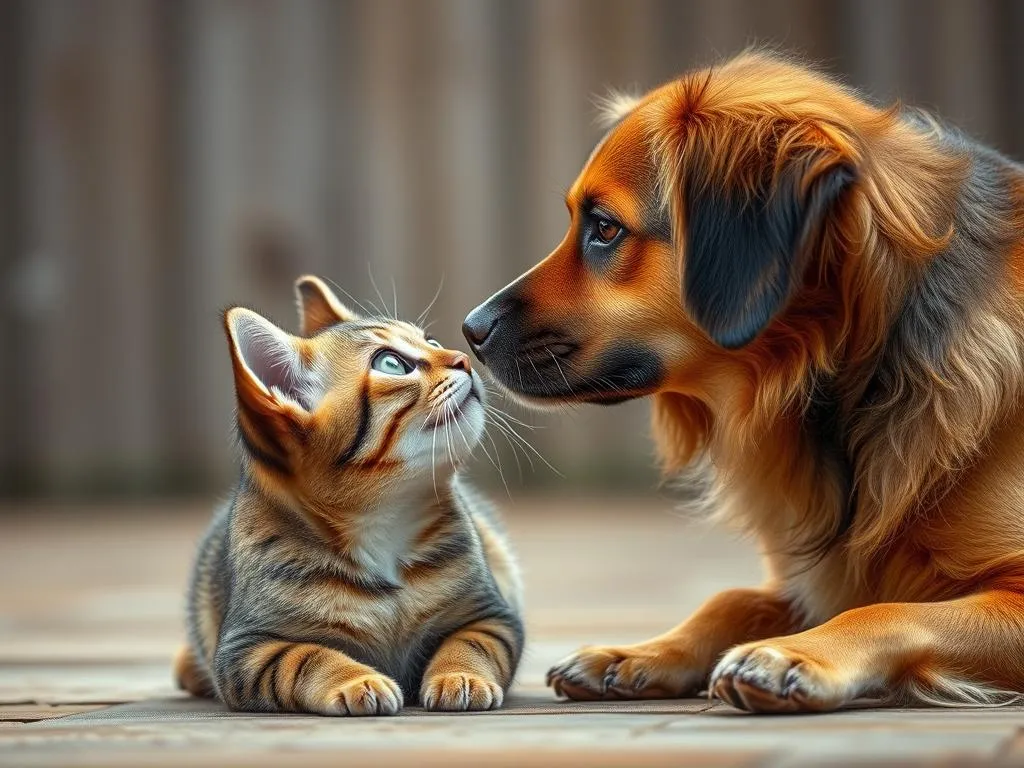
Introducing a cat to a dog can be a daunting experience for many pet owners. With the natural instincts of both animals often at odds, it’s no wonder that this introduction can lead to stress and anxiety for both pets and their humans. However, with the right approach, you can facilitate a harmonious relationship between your cat and dog, allowing them to coexist peacefully in your home.
A successful introduction not only benefits the pets involved but also enhances your home environment. Cats and dogs can provide companionship for each other, reducing loneliness and boredom. Understanding how to properly introduce a cat to a dog can lead to a happier household, so let’s dive into the steps necessary to make this process as smooth as possible.
Understanding Cat and Dog Behavior
Basic Instincts
To effectively introduce a cat to a dog, it’s crucial to understand the basic instincts of both animals. Dogs are pack animals, often governed by their social hierarchy. They might see a new cat as a potential playmate or even as a prey item, depending on their temperament and breed. On the other hand, cats are solitary hunters, and their instincts often lead them to be wary of larger animals, including dogs.
These differing instincts can lead to conflict. While some dogs may be friendly and eager to play, a cat may perceive this behavior as a threat. Conversely, a frightened dog may react defensively, leading to aggression. Recognizing these instincts helps in framing the introduction process and setting expectations.
Body Language Signs
Being able to read body language in both cats and dogs is essential during the introduction process. Dogs will often communicate their feelings through their posture, ears, and tail position. A relaxed dog will exhibit a loose body, wagging tail, and relaxed ears. In contrast, a tense dog may have a stiff body, raised hackles, and a tucked tail.
For cats, signs of comfort include purring, slow blinking, and a relaxed posture. When a cat is stressed, it may hiss, puff up its fur, or try to hide. Recognizing these signals can help you gauge the comfort levels of both pets, allowing you to move forward at a pace that suits them.
Preparing for the Introduction
Assessing Your Pets’ Temperament
Before initiating the introduction, it’s important to assess the temperament of both your cat and dog. Consider their individual personalities and breed traits. For instance, some dog breeds are naturally more curious and energetic, while others may be more laid-back. Similarly, your cat’s personality can range from bold to shy.
Take the time to observe how your pets interact with other animals or new people. If your dog has a history of aggression or your cat tends to be skittish, you may need to take extra precautions during the introduction process.
Creating a Safe Environment
Establishing a safe environment is imperative for a successful introduction. Designate separate areas for your cat and dog, ensuring they have their own space where they can retreat if they feel overwhelmed. This not only gives them a sense of security but also allows them to acclimate to each other’s scents and sounds without direct confrontation.
Make sure to provide escape routes for both pets. If your dog gets too excited, your cat should have a safe place to escape, like a high perch or a separate room. This setup helps reduce the chances of conflict and allows each pet to feel secure.
Tools and Supplies
Having the right tools on hand can make the introduction process smoother. Consider these essential items:
- Leashes: For controlling your dog during initial meetings.
- Crates or carriers: To create a safe space for your cat.
- Treats: Use these for positive reinforcement during the introduction process.
- Feliway or DAP diffusers: These products can help calm your pets and reduce stress.
Using positive reinforcement tools will encourage good behavior and make the experience more enjoyable for both pets.
The Introduction Process
Initial Introductions
The introduction process should begin with controlled interactions. Start by allowing your pets to become familiar with each other’s scents. You can do this by swapping bedding or using a cloth to rub each pet, then letting them smell the cloth. This scent swapping helps them build a familiarity before any face-to-face meetings.
Controlled Meetings
Once both pets have had a chance to acclimate to each other’s scents, you can move on to controlled meetings. Keep your dog on a leash and allow them to enter the room where your cat is located. Ensure that your cat has a safe space to retreat to, such as a high shelf or a separate room.
During this first meeting, observe their reactions closely. If either pet shows signs of stress or aggression, it’s essential to separate them immediately and allow them to calm down. Never force interactions; let them happen at their own pace.
Gradual Exposure
After the initial introductions, gradually increase the duration and frequency of their interactions. Start with short, controlled meetings, gradually lengthening the time as both pets show signs of comfort. Monitor their behavior closely during these sessions, adjusting your approach as needed. If stress signals emerge, take a step back and allow more time for acclimatization.
Managing Conflict
Recognizing Signs of Stress
As you continue to introduce your cat to your dog, be vigilant about recognizing signs of stress in both animals. Common warning signs include growling, hissing, raised fur, and a stiff body posture. If you notice any of these signs, it’s crucial to intervene before the situation escalates.
Intervening Safely
In the event of a confrontation, your priority should be the safety of both pets. Avoid yelling or using physical punishment, as this can escalate the situation. Instead, calmly redirect your dog’s attention using treats or toys. If necessary, guide your dog away using the leash, ensuring the cat has a chance to escape to a safe area.
Reassessing the Situation
If the introduction process becomes consistently stressful or aggressive, it may be necessary to reassess your approach. Some pets require more time to adapt than others. Remember that patience is key; forcing interactions can lead to long-term behavioral issues.
Long-Term Coexistence Strategies
Building Positive Associations
Once your cat and dog have successfully met and shown signs of comfort, focus on building positive associations between them. Engage in interactive play sessions where both pets can participate, utilizing toys that encourage cooperative play. Additionally, offer treats and praise during these interactions to reinforce positive behavior.
Establishing Routines
Incorporating both pets into your daily routines can help solidify their relationship. Establish consistent feeding times, playtime, and training sessions. By creating a predictable environment, both pets can feel more secure and less anxious around each other.
Continuous Monitoring
Regularly check in on their relationship even after the initial introduction process. Observe their interactions for signs of harmony or stress. If you notice any issues, don’t hesitate to intervene and address them promptly. Continuous monitoring helps ensure that both pets feel comfortable and secure in their shared space.
Common Pitfalls to Avoid
Rushing the Process
One of the biggest mistakes pet owners make is rushing the introduction process. Remember that every pet is different, and some may require more time than others to adjust. Rushing can lead to increased stress and potential aggression. Take the time to go through each step at a pace that suits both animals.
Ignoring Body Language
Ignoring body language signals can lead to misunderstandings and conflict. Always be vigilant and responsive to your pets’ cues. Misreading signs of stress or aggression can escalate a situation quickly, leading to negative experiences for both pets.
Lack of Supervision
Supervision is essential, especially during the early stages of introduction. Unsupervised interactions can lead to accidents or altercations. Ensure that you are present to manage their interactions and intervene if necessary. As they grow more comfortable with each other, you can gradually allow for shorter supervised periods.
Conclusion
Introducing a cat to a dog is a process that requires patience, understanding, and careful planning. By recognizing the instincts and body language of each pet, preparing a safe environment, and following a structured introduction process, you can foster a harmonious relationship between your cat and dog.
Remember to take things slowly, monitor their interactions, and build positive associations through shared experiences. With time and dedication, your home can become a peaceful coexistence zone for both your furry friends.
Introducing a new member to your family can be challenging, but it’s also incredibly rewarding. Keep an open mind, be patient, and embrace the journey of helping your cat and dog become the best of friends.









